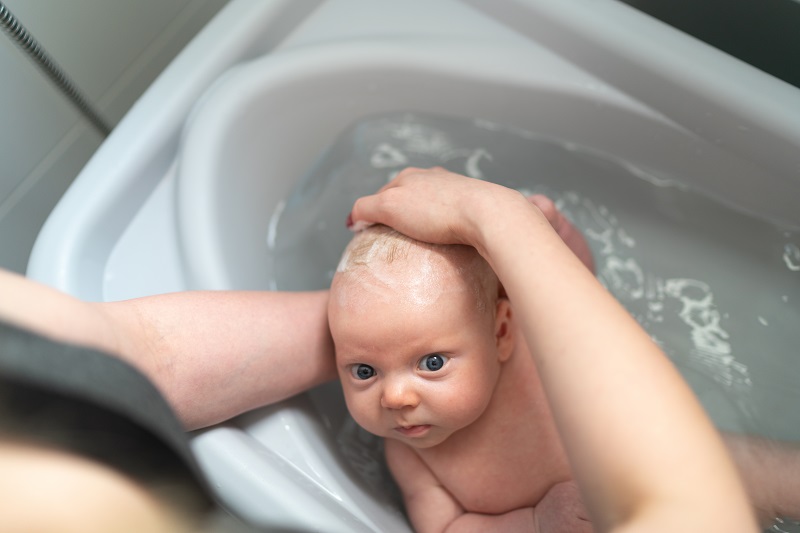Bathing 101: How to Bathe Your New Baby

January 13, 2023
It’s an exciting time for new parents when their baby can finally come home. They have the opportunity to introduce them to everything—even the most basic of things like bathing.
A newborn’s size can make the task a little scary, but getting into a routine can help.
Newborns don’t need daily baths. “Anywhere from two to three times a week is sufficient,” says Moses Olorunnisola, M.D., a pediatrician with Hackensack Meridian Health Medical Group. “Doing it too often can dry out their skin.”
Here is your step-by-step guide to bathing your baby—both before the umbilical cord stump falls off and after.
Before the Umbilical Cord Stump Falls Off
Babies should only have sponge baths until the umbilical cord stump falls off – the stump should be kept dry to prevent infection. The cord stump usually falls off within the first few weeks after birth.
Step 1: Prepare supplies
The first step is to gather all your supplies and have them ready, including a basin of warm water, washcloth, soap and towel.
Dr. Olorunnisola also advises: “Make sure the room where the baby is going to be bathed is at least 75 degrees – babies can’t retain their body heat as well as adults, especially while naked, so a warm room will help with the adjustment.”
Step 2: Prepare the baby
Once all the supplies are readied, it’s time to undress the baby and wrap them in a towel, preferably one with a hood. Place them where the sponge bath is going to take place. It could be done on the floor, a changing table or a counter.
If you are doing the bath off the floor, Dr. Olorunnisola urges people to remember: “It is extremely important to always have them secured or a hand on them.”
Step 3: Bathe baby
Clean from top down and only unwrap the area you are cleaning. To start, take the hood off and dip the washcloth in the warm water and wipe the head and neck, including around the eyes, nose, mouth and ears. Once that is done, dry the baby in that area and put the hood back up.
Next, unwrap and wipe the torso and back. Be careful around the umbilical cord. Pat dry, then move on to the lower half.
Unwrap and wipe the legs. Be careful in the groin area if the baby is male and has recently been circumcised. Try to avoid that area unless otherwise directed by your doctor.
Once done, finish drying the baby, put on a new diaper and clothes, and you’re all done.
After the Umbilical Cord Stump Falls Off
When the cord is off, babies can start having full baths in a baby tub.
Step 1: Prepare supplies
The first step is to gather all your supplies and have them ready, including a washcloth, soap and towel. Make sure the room temperature is at least 75 degrees.
“Fill the tub with no more than 2–3 inches of water,” says Dr. Olorunnisola. Double check the water temp before placing the baby in the tub – you can use your elbow or wrist to feel the water. The water should be warm, not hot. If you use a thermometer, an ideal temperature is about 100°F.
Lower the baby feet first into the tub, and make sure the baby’s head is well above the water. Support the baby’s head and neck with one hand, and use the other for washing.
Step 2: Bathe baby
As with sponge baths, work your way down. There is no need to scrub hard or use strong-smelling soaps. If you do use soap, it’s better to use a mild, unscented, hypoallergenic soap.
Step 3: Dry off baby
Once the baby is clean, they can be dried off. A mild, unscented moisturizer can be used if you wish.
Bath time can be fun, but as Dr. Olorunnisola stresses: “You never want to leave your baby unsupervised even for a second. If you need to leave the room, you have to take your baby with you.”
Next Steps & Resources:
- Meet our expert: Moses Olorunnisola, M.D.
- To make an appointment with Dr. Olorunnisola or a pediatrician near you, call 800-822-8905 or visit our website.
- Find a parenting or newborn class near you.
The material provided through HealthU is intended to be used as general information only and should not replace the advice of your physician. Always consult your physician for individual care.






